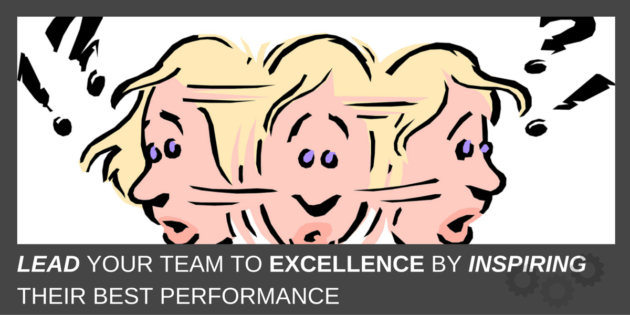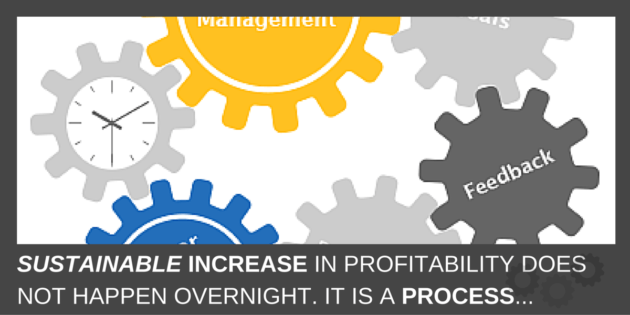Accountability is obviously critical to the success of any business. After all, every business strategy has to be executed through people. Assuming the strategy is sound, the efficiency with which they execute the strategy determines the degree of profitability. Thus, holding people accountable to the strategy is essential to success.
Because my practice focuses upon development or refinement of business strategy and execution through the Critical Factors Management System, people have referred to me as ‘Mr. Accountability’. I am sure this conjures up images of a hired hand that goes into companies with a big stick and makes sure everyone is productive. My clients understand, however, that my philosophy with regard to accountability has nothing to do with using a stick – or a carrot for that matter.
In fact, while you can motivate people with either a carrot (reward) or a stick (threat), I don’t advocate either because both require that you be present in order to achieve the performance you are seeking. At best, this achieves what I refer to as Level 1 Accountability.
Level 1 Accountability is merely establishing goals, allocating accountability and holding people responsible for results. While many companies don’t even achieve that level of accountability, if that was the extent of my practice, there really wouldn’t be anything unique about what I offer. Thus, let me use this football analogy to explain Level 2 and Level 3 Accountability in order to provide perspective on the magic of Level 3 Accountability.
Most of us who love football love it because of the amount of strategy employed. Yes, to the casual viewer, it appears to be a simple game of brute strength but, in fact, with most teams pretty much evenly matched in terms of athleticism, at the end of the day, the game is won or lost based upon strategy and execution of the strategy.
Remember the 2011 Playoff series? Every game was decided as a result of a split second lapse in concentration. In all instances, the teams were physically similar, well prepared and the strategies were almost equally matched – the games were decided upon errors in execution. And my GIANTS won the Superbowl! (but I digress…)
That said, let’s get back to strategy in football and how football and business are similar. In fact, bringing it back to business for a moment, my philosophy is that there are three steps to success in business:
- Clear & Quantifiable Goals
- Comprehensive Strategy
- Systematic Execution of the Strategy
Back to football:
- Every member of every team and every team has a Clear & Quantifiable Goal – Win the Superbowl
- Every team has their own specialized strategy (their offensive and defensive playbooks)
- Every team has to execute their strategy in order to achieve the goal
Briefly, with regard to goals, the primary goal in football is to win the Superbowl which means winning regular season and then playoff season games.
With regard to strategy, however, every team is different. There are various descriptions of NFL offenses, for instance, including some interestingly named such as Smashmouth, Pistol, Vertical Passing,West Coast, Run-and-Shoot, Spread, Spread Option and Read Option.
Every team has their own strategy and they develop a game plan each week based upon that strategy. They don’t, however, simply implement the same strategy each week. They look at their strategy, anticipate every conceivable situation that might occur during a game and come up with contingencies. So football teams employ what I refer to as Comprehensive strategy.
For example, they may have a play for 2nd and 11 but that play will be different depending upon field position, time on the clock, the way the wind is blowing, player injuries, etc. (And in business, it is essential to have contingencies built into your strategy as well but let’s stick to the football analogy for the moment.)
Okay, so each team has different strategies and those strategies will change at any given moment depending upon the situation on the field. But think about this – every team’s strategy is so well conceived and so clearly communicated that, during the game, when the quarterback steps into the huddle, no one is asking questions and no one is making suggestions. He simply says three things – the formation, the play and the count and everyone in that huddle immediately knows their assignment (which could change on the line of scrimmage depending upon the way the defense lines up but that’s more about about skills, knowledge and training and beyond the scope of this article).
So let’s assume that the quarterback has called a pass play. He repeats it twice and they break from the huddle. He stands in shotgun formation and takes the snap from center. As he scans the field he sees his receiver wide open down the right sideline because the defensive back has fallen. He steps into the throw for an easy touchdown but, just as he is about to release, he gets creamed by a defensive tackle.
Now, you won’t see the owner of the team come down from the box, run onto the field and scream at the guard who missed his block. You won’t see the coach come running off the sideline and into the huddle to yell at the guard who missed his block. And, for the most part, while they may give him a sideways glance (Level 2 Accountability – members of the team holding each other accountable), you won’t see the other members of the team scream at the guard who missed his block. Why?
While there may be many thoughts on this, the simple answer is this:
- EVERYONE on the team is working towards the same goal
- EVERYONE on the team knows the strategy so well that not only do they know their own assignments, they pretty much know everyone else’s as well
- That guard KNOWS that he alone did not execute. He knows that he let the team down. And he knows that everyone else on the team knows he let them down. They are all in this together.
There is no need to scream at him. He already feels bad for missing the block. He is holding himself accountable. And that is Level 3 Accountability – when members of the team hold themselves accountable. And there is only one way to create Level 3 Accountability – you must INSPIRE rather than motivate people; the difference being that motivation is an external force imposed upon people whereas inspiration is touching something within that person.
And, in order to inspire people, you must give them a sense of being part of something they believe in that will be bigger than the sum of its parts (not just a company, but a company that stands for something great). You must give them a clear understanding of the goal and a sense of ownership in that goal. You must give them a clear understanding of the strategy and their ability to contribute to the strategy so that they have a sense of ownership. You must give them a clear understanding of their role in executing the strategy. And you must monitor the performance of each member of the team and the team as a whole consistently, objectively and transparently.
In other words, in order to create Level 3 Accountability in your organization, you must have:
- Clearly Defined Goals
- Understanding and Buy-In to the Strategy
- Consistent, Objective and Transparent measurement of performance
In football, it is easy to see who is performing and who is not on every play of the game. While the spectators may have a question now and then about who blew and assignment, no one on the football team has any question. Can you say that about your business? Does your team share your vision (Goal). Do they understand the strategy? Equally important, have they bought into the strategy? (If they don’t believe it, they won’t achieve it). And, does everyone on your team know how their personal performance impacts the execution of the overall strategy?
If the answers to any of these questions is ‘no’, then you can’t have Level 3 Accountability. And if you don’t have Level 3 Accountability, your organization is not going to achieve its full potential.
By the way, do you want Level 3 Accountability? If you haven’t done it already, download our FREE PIP Checklist for 7 Steps that will assist you to achieve Level 3 Accountability. If you already have THE PIP Checklist and want a step by step guide for implementing the 7 Steps, get THE PIP Manual.
In summary:
- Level 1 Accountability – tell people what to do and then hold them accountable; watch them carefully and always be prepared to dangle a carrot or threaten with a stick but, understand that, in your absence, performance will drop off
- Level 2 Accountability – clearly communicate the strategy, allocate accountability and ensure that performance measurement is transparent to the whole team. Members of the team will hold each other accountable and, done properly, do so in a positive manner.
- Level 3 Accountability – ensure that the goal and the strategy are clearly communicated, allow the team to participate in establishing the goals and the strategy, inspire (as opposed to motivate) excellence by giving members of the team ownership of their responsibilities and a clear understanding of how their performance impacts the rest of the team, create a consistent, objective and transparent means of measuring performance, take timely appropriate action (including praise for exceeding expectations) and watch the transformation in your company as people hold each other and then themselves accountable
By the way, do you need Level 3 Accountability? According to a recent article published on the Harvard Business Review Blog Network, “Gallup’s research shows that engagement among US workers is holding steady at a scant 30%. This means seven out of ten people are either “checked out”, or actively hostile toward their employers. Seven out of ten.”
Download THE PIP Checklist and see how many of the 7 Steps can help you create Level 3 Accountability today!




